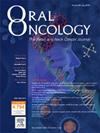Analysis of AI foundation model features decodes the histopathologic landscape of HPV-positive head and neck squamous cell carcinomas
IF 4
2区 医学
Q1 DENTISTRY, ORAL SURGERY & MEDICINE
引用次数: 0
Abstract
Objectives
Human papillomavirus (HPV) influences the pathobiology of Head and Neck Squamous Cell Carcinomas (HSNCCs). While deep learning shows promise in detecting HPV from hematoxylin and eosin (H&E) stained slides, the histologic features utilized remain unclear. This study leverages artificial intelligence (AI) foundation models to characterize histopathologic features associated with HPV presence and objectively describe patterns of variability in the HPV-positive space.
Materials and Methods
H&E images from 981 HNSCC patients across public and institutional datasets were analyzed. We used UNI, a foundation model based on self-supervised learning (SSL), to map the landscape of HNSCC histology and identify the axes of SSL features that best separate HPV-positive and HPV-negative tumors. To interpret the histologic features that vary across different regions of this landscape, we used HistoXGAN, a pretrained generative adversarial network (GAN), to generate synthetic histology images from SSL features, which a pathologist rigorously assessed.
Results
Analyzing AI-generated synthetic images found distinctive features of HPV-positive histology, such as smaller, paler, more monomorphic nuclei; purpler, amphophilic cytoplasm; and indistinct cell borders with rounded tumor contours. The SSL feature axes we identified enabled accurate prediction of HPV status from histology, achieving validation sensitivity and specificity of 0.81 and 0.92, respectively. Our analysis subdivided image tiles from HPV-positive histology into three overlapping subtypes: border, inflamed, and stroma.
Conclusion
Foundation-model-derived synthetic pathology images effectively capture HPV-related histology. Our analysis identifies distinct subtypes within HPV-positive HNSCCs and enables accurate, explainable detection of HPV presence directly from histology, offering a valuable approach for low-resource clinical settings.
AI基础模型特征分析可解码hpv阳性头颈部鳞状细胞癌的组织病理格局
目的探讨人乳头瘤病毒(HPV)对头颈部鳞状细胞癌(HSNCCs)病理生物学的影响。虽然深度学习有望从苏木精和伊红(H&;E)染色的载玻片中检测HPV,但所使用的组织学特征仍不清楚。本研究利用人工智能(AI)基础模型来表征与HPV存在相关的组织病理学特征,并客观地描述HPV阳性空间的变异模式。材料和方法对来自公共和机构数据集的981例HNSCC患者的E图像进行分析。我们使用UNI,一个基于自我监督学习(SSL)的基础模型,来绘制HNSCC组织学景观,并确定SSL特征的轴,这些特征最能区分hpv阳性和hpv阴性肿瘤。为了解释该景观不同区域的组织学特征,我们使用了HistoXGAN,一种预训练的生成对抗网络(GAN),从SSL特征生成合成组织学图像,病理学家对其进行了严格的评估。结果对人工智能合成图像进行分析,发现hpv阳性的组织学特征明显,细胞核更小、更苍白、单核形态更多;紫色,两亲性细胞质;细胞边界模糊,肿瘤轮廓呈圆形。我们确定的SSL特征轴能够从组织学上准确预测HPV状态,验证灵敏度和特异性分别为0.81和0.92。我们的分析将hpv阳性组织学的图像块细分为三个重叠的亚型:边界型、炎症型和间质型。结论基于基础模型的合成病理图像能有效捕获hpv相关组织学。我们的分析确定了HPV阳性HNSCCs中不同的亚型,并能够直接从组织学中准确、可解释地检测HPV的存在,为低资源的临床环境提供了有价值的方法。
本文章由计算机程序翻译,如有差异,请以英文原文为准。
求助全文
约1分钟内获得全文
求助全文
来源期刊

Oral oncology
医学-牙科与口腔外科
CiteScore
8.70
自引率
10.40%
发文量
505
审稿时长
20 days
期刊介绍:
Oral Oncology is an international interdisciplinary journal which publishes high quality original research, clinical trials and review articles, editorials, and commentaries relating to the etiopathogenesis, epidemiology, prevention, clinical features, diagnosis, treatment and management of patients with neoplasms in the head and neck.
Oral Oncology is of interest to head and neck surgeons, radiation and medical oncologists, maxillo-facial surgeons, oto-rhino-laryngologists, plastic surgeons, pathologists, scientists, oral medical specialists, special care dentists, dental care professionals, general dental practitioners, public health physicians, palliative care physicians, nurses, radiologists, radiographers, dieticians, occupational therapists, speech and language therapists, nutritionists, clinical and health psychologists and counselors, professionals in end of life care, as well as others interested in these fields.
 求助内容:
求助内容: 应助结果提醒方式:
应助结果提醒方式:


